2009 DODGE DAKOTA radiator cap
[x] Cancel search: radiator capPage 368 of 449
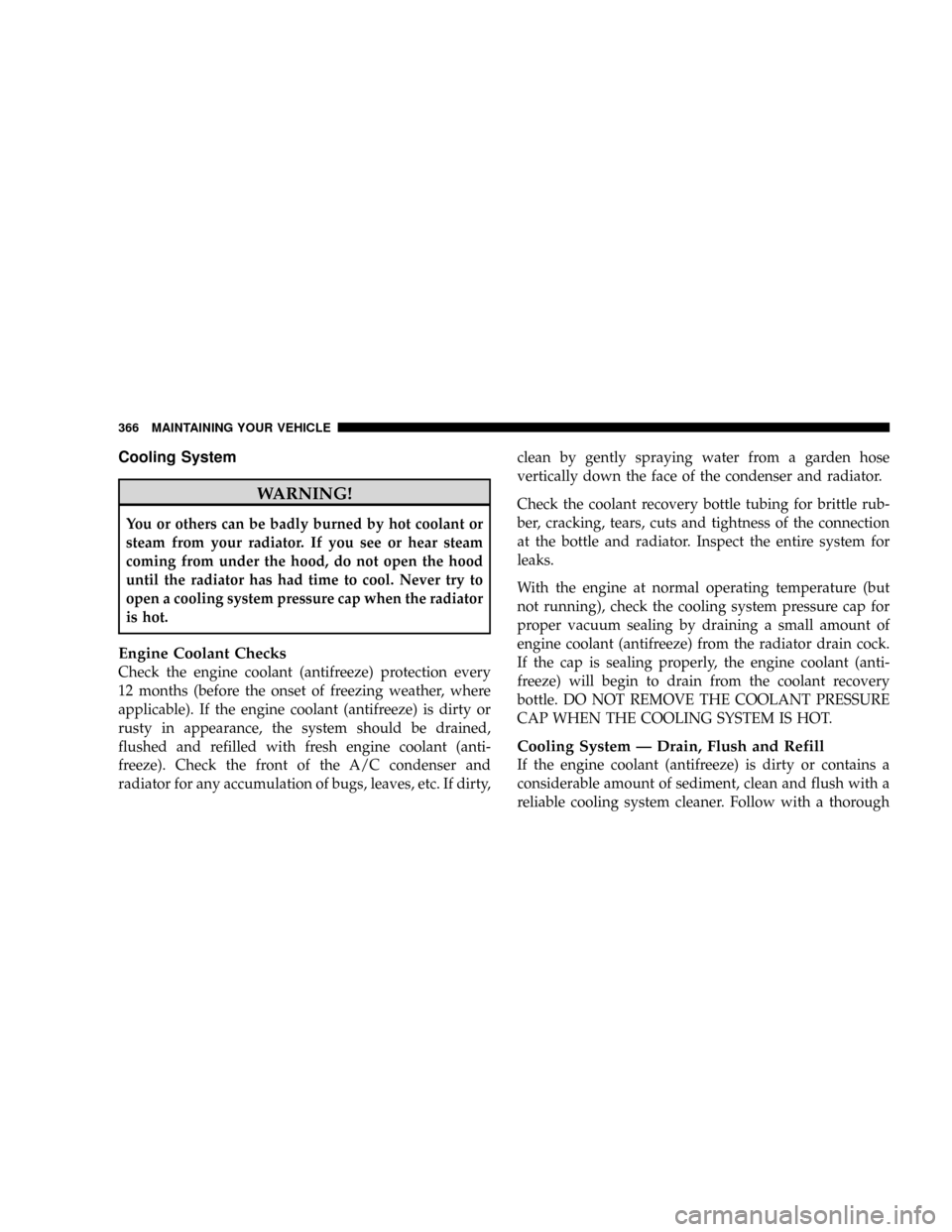
Cooling System
WARNING!
You or others can be badly burned by hot coolant or
steam from your radiator. If you see or hear steam
coming from under the hood, do not open the hood
until the radiator has had time to cool. Never try to
open a cooling system pressure cap when the radiator
is hot.
Engine Coolant Checks
Check the engine coolant (antifreeze) protection every
12 months (before the onset of freezing weather, where
applicable). If the engine coolant (antifreeze) is dirty or
rusty in appearance, the system should be drained,
flushed and refilled with fresh engine coolant (anti-
freeze). Check the front of the A/C condenser and
radiator for any accumulation of bugs, leaves, etc. If dirty,clean by gently spraying water from a garden hose
vertically down the face of the condenser and radiator.
Check the coolant recovery bottle tubing for brittle rub-
ber, cracking, tears, cuts and tightness of the connection
at the bottle and radiator. Inspect the entire system for
leaks.
With the engine at normal operating temperature (but
not running), check the cooling system pressure cap for
proper vacuum sealing by draining a small amount of
engine coolant (antifreeze) from the radiator drain cock.
If the cap is sealing properly, the engine coolant (anti-
freeze) will begin to drain from the coolant recovery
bottle. DO NOT REMOVE THE COOLANT PRESSURE
CAP WHEN THE COOLING SYSTEM IS HOT.
Cooling System Ð Drain, Flush and Refill
If the engine coolant (antifreeze) is dirty or contains a
considerable amount of sediment, clean and flush with a
reliable cooling system cleaner. Follow with a thorough
366 MAINTAINING YOUR VEHICLE
Page 370 of 449
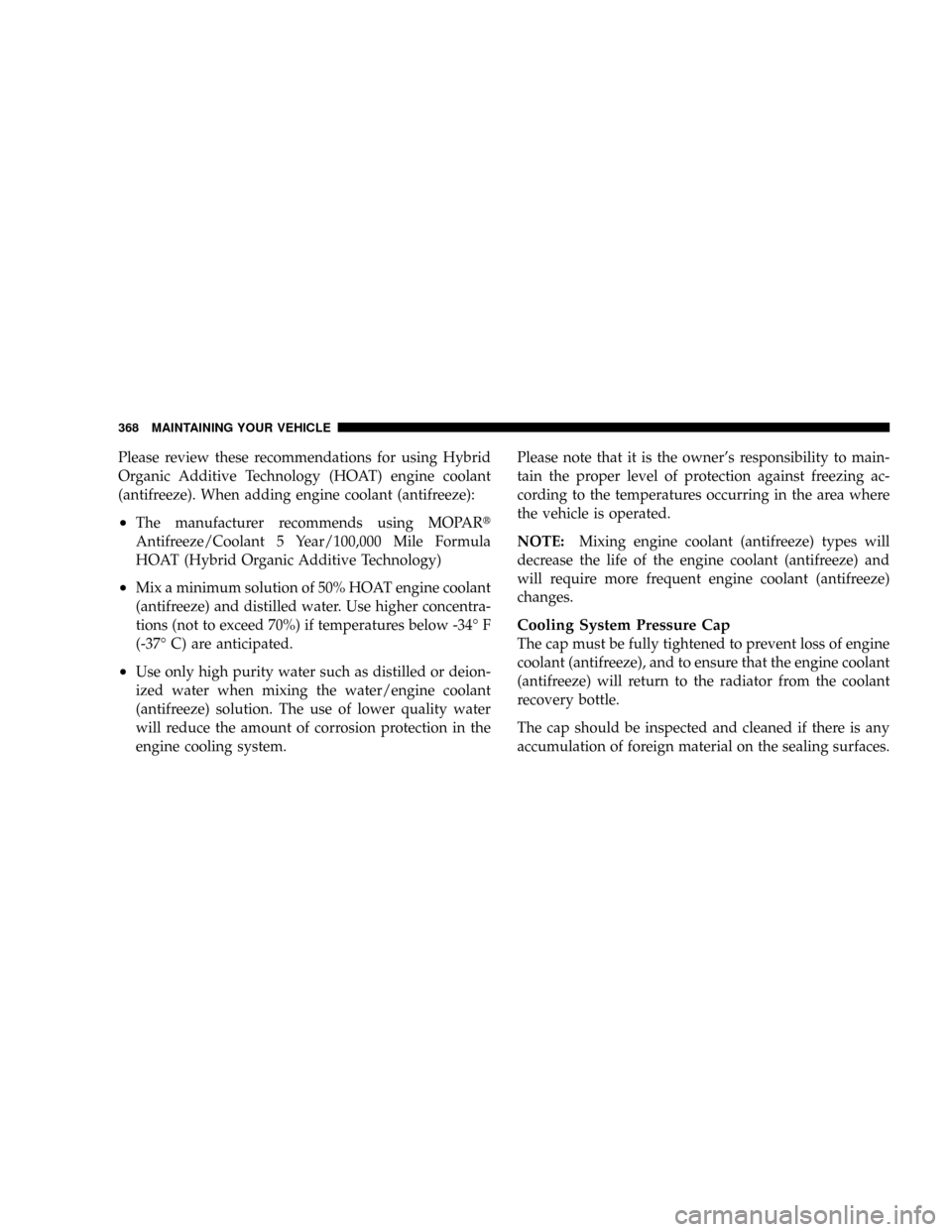
Please review these recommendations for using Hybrid
Organic Additive Technology (HOAT) engine coolant
(antifreeze). When adding engine coolant (antifreeze):
²The manufacturer recommends using MOPARt
Antifreeze/Coolant 5 Year/100,000 Mile Formula
HOAT (Hybrid Organic Additive Technology)
²Mix a minimum solution of 50% HOAT engine coolant
(antifreeze) and distilled water. Use higher concentra-
tions (not to exceed 70%) if temperatures below -34É F
(-37É C) are anticipated.
²Use only high purity water such as distilled or deion-
ized water when mixing the water/engine coolant
(antifreeze) solution. The use of lower quality water
will reduce the amount of corrosion protection in the
engine cooling system.Please note that it is the owner's responsibility to main-
tain the proper level of protection against freezing ac-
cording to the temperatures occurring in the area where
the vehicle is operated.
NOTE:Mixing engine coolant (antifreeze) types will
decrease the life of the engine coolant (antifreeze) and
will require more frequent engine coolant (antifreeze)
changes.
Cooling System Pressure Cap
The cap must be fully tightened to prevent loss of engine
coolant (antifreeze), and to ensure that the engine coolant
(antifreeze) will return to the radiator from the coolant
recovery bottle.
The cap should be inspected and cleaned if there is any
accumulation of foreign material on the sealing surfaces.
368 MAINTAINING YOUR VEHICLE
Page 371 of 449
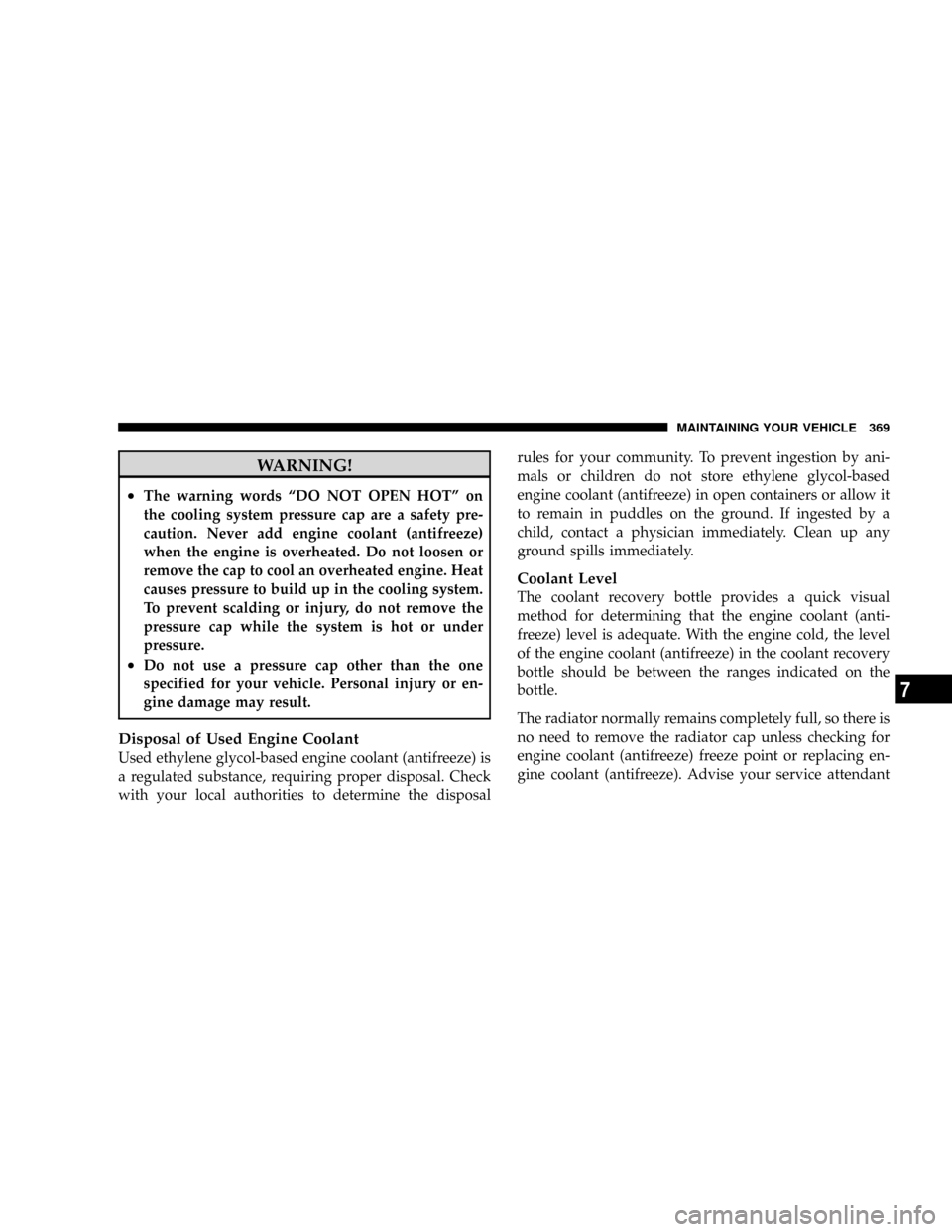
WARNING!
²The warning words ªDO NOT OPEN HOTº on
the cooling system pressure cap are a safety pre-
caution. Never add engine coolant (antifreeze)
when the engine is overheated. Do not loosen or
remove the cap to cool an overheated engine. Heat
causes pressure to build up in the cooling system.
To prevent scalding or injury, do not remove the
pressure cap while the system is hot or under
pressure.
²Do not use a pressure cap other than the one
specified for your vehicle. Personal injury or en-
gine damage may result.
Disposal of Used Engine Coolant
Used ethylene glycol-based engine coolant (antifreeze) is
a regulated substance, requiring proper disposal. Check
with your local authorities to determine the disposalrules for your community. To prevent ingestion by ani-
mals or children do not store ethylene glycol-based
engine coolant (antifreeze) in open containers or allow it
to remain in puddles on the ground. If ingested by a
child, contact a physician immediately. Clean up any
ground spills immediately.
Coolant Level
The coolant recovery bottle provides a quick visual
method for determining that the engine coolant (anti-
freeze) level is adequate. With the engine cold, the level
of the engine coolant (antifreeze) in the coolant recovery
bottle should be between the ranges indicated on the
bottle.
The radiator normally remains completely full, so there is
no need to remove the radiator cap unless checking for
engine coolant (antifreeze) freeze point or replacing en-
gine coolant (antifreeze). Advise your service attendant
MAINTAINING YOUR VEHICLE 369
7
Page 373 of 449
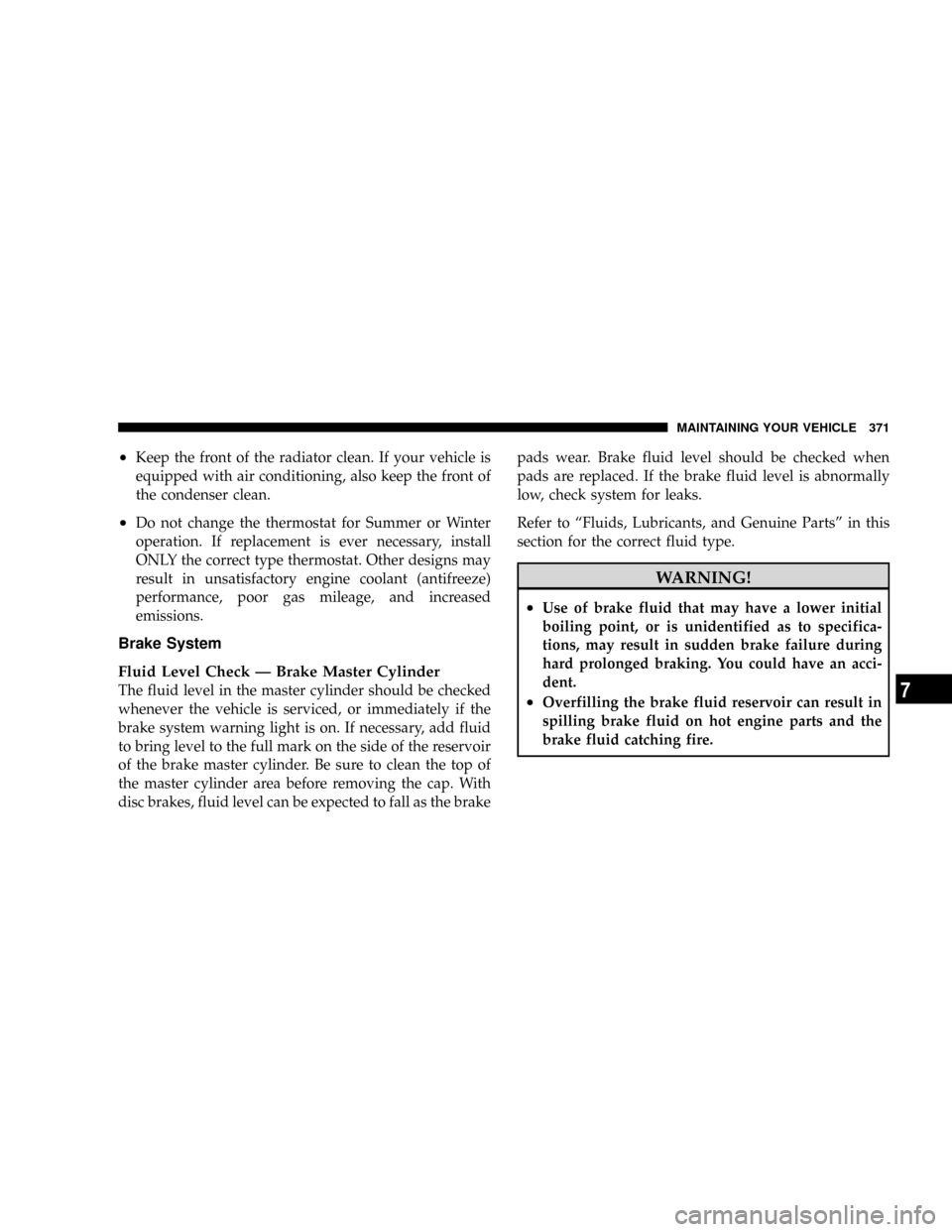
²Keep the front of the radiator clean. If your vehicle is
equipped with air conditioning, also keep the front of
the condenser clean.
²Do not change the thermostat for Summer or Winter
operation. If replacement is ever necessary, install
ONLY the correct type thermostat. Other designs may
result in unsatisfactory engine coolant (antifreeze)
performance, poor gas mileage, and increased
emissions.
Brake System
Fluid Level Check Ð Brake Master Cylinder
The fluid level in the master cylinder should be checked
whenever the vehicle is serviced, or immediately if the
brake system warning light is on. If necessary, add fluid
to bring level to the full mark on the side of the reservoir
of the brake master cylinder. Be sure to clean the top of
the master cylinder area before removing the cap. With
disc brakes, fluid level can be expected to fall as the brakepads wear. Brake fluid level should be checked when
pads are replaced. If the brake fluid level is abnormally
low, check system for leaks.
Refer to ªFluids, Lubricants, and Genuine Partsº in this
section for the correct fluid type.
WARNING!
²Use of brake fluid that may have a lower initial
boiling point, or is unidentified as to specifica-
tions, may result in sudden brake failure during
hard prolonged braking. You could have an acci-
dent.
²Overfilling the brake fluid reservoir can result in
spilling brake fluid on hot engine parts and the
brake fluid catching fire.
MAINTAINING YOUR VEHICLE 371
7
Page 431 of 449
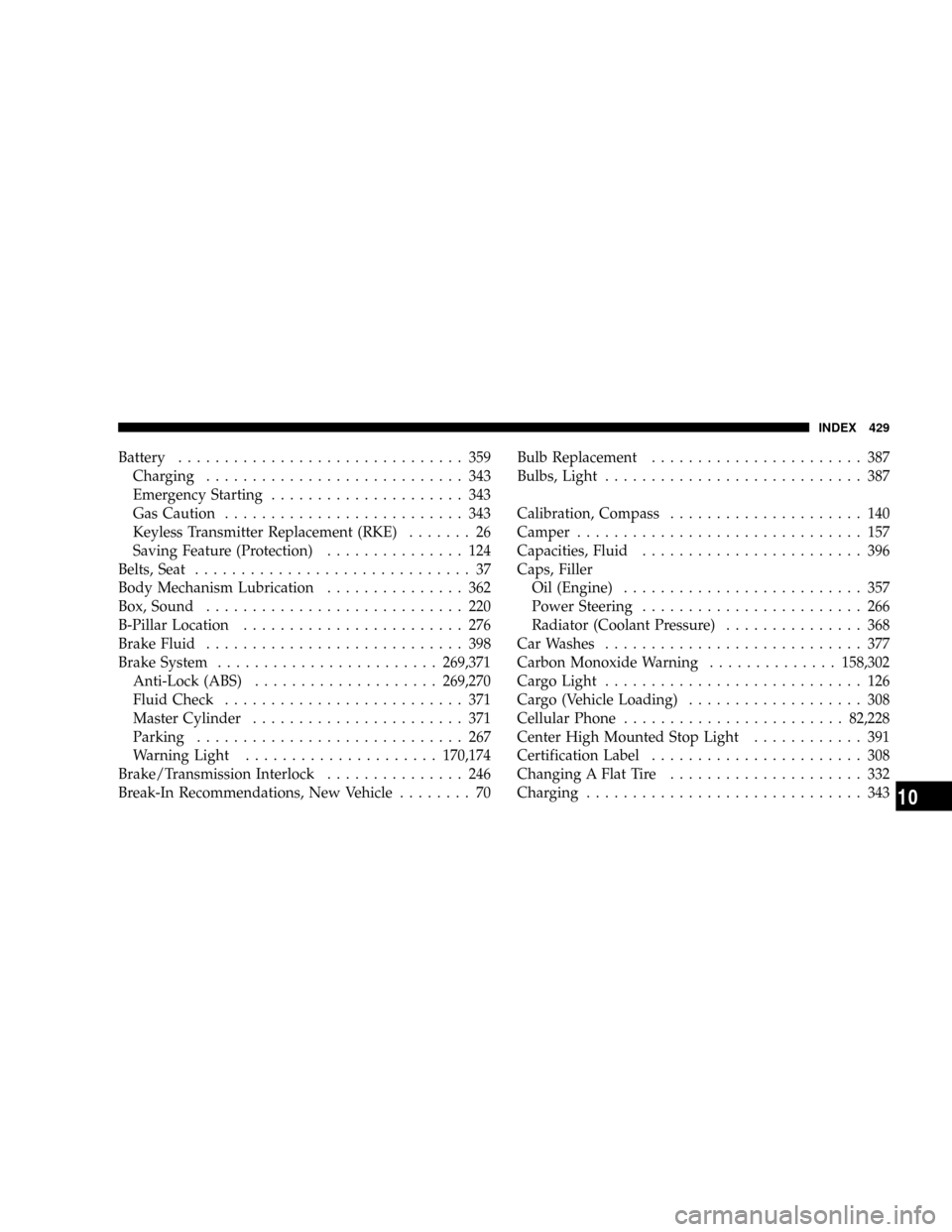
Battery............................... 359
Charging............................ 343
Emergency Starting..................... 343
Gas Caution.......................... 343
Keyless Transmitter Replacement (RKE)....... 26
Saving Feature (Protection)............... 124
Belts, Seat.............................. 37
Body Mechanism Lubrication............... 362
Box, Sound............................ 220
B-Pillar Location........................ 276
Brake Fluid............................ 398
Brake System........................269,371
Anti-Lock (ABS)....................269,270
Fluid Check.......................... 371
Master Cylinder....................... 371
Parking............................. 267
Warning Light.....................170,174
Brake/Transmission Interlock............... 246
Break-In Recommendations, New Vehicle........ 70Bulb Replacement....................... 387
Bulbs, Light............................ 387
Calibration, Compass..................... 140
Camper............................... 157
Capacities, Fluid........................ 396
Caps, Filler
Oil (Engine).......................... 357
Power Steering........................ 266
Radiator (Coolant Pressure)............... 368
Car Washes............................ 377
Carbon Monoxide Warning..............158,302
Cargo Light............................ 126
Cargo (Vehicle Loading)................... 308
Cellular Phone........................82,228
Center High Mounted Stop Light............ 391
Certification Label....................... 308
Changing A Flat Tire..................... 332
Charging.............................. 343
INDEX 429
10
Page 432 of 449
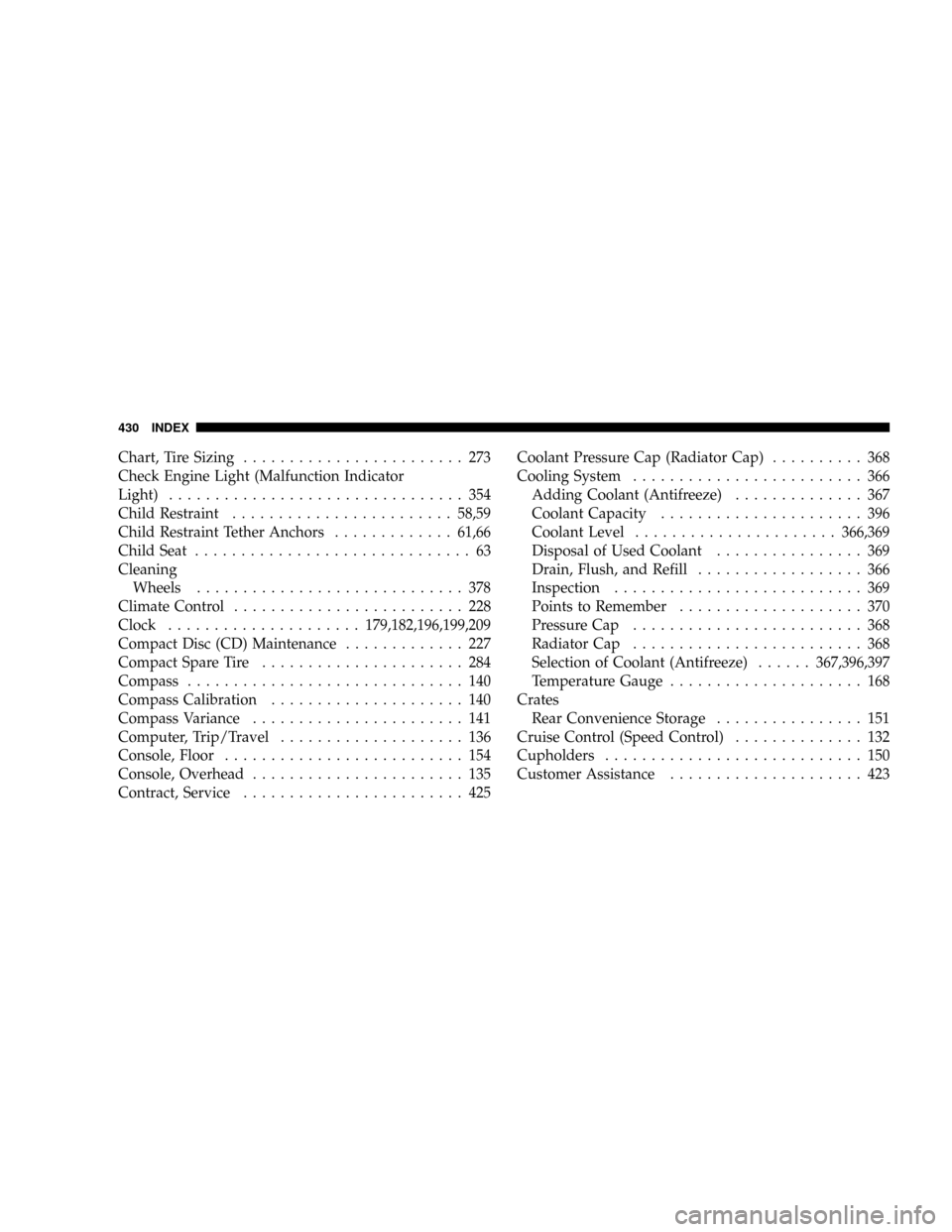
Chart, Tire Sizing........................ 273
Check Engine Light (Malfunction Indicator
Light)................................ 354
Child Restraint........................58,59
Child Restraint Tether Anchors.............61,66
Child Seat.............................. 63
Cleaning
Wheels............................. 378
Climate Control......................... 228
Clock.....................179,182,196,199,209
Compact Disc (CD) Maintenance............. 227
Compact Spare Tire...................... 284
Compass.............................. 140
Compass Calibration..................... 140
Compass Variance....................... 141
Computer, Trip/Travel.................... 136
Console, Floor.......................... 154
Console, Overhead....................... 135
Contract, Service........................ 425Coolant Pressure Cap (Radiator Cap).......... 368
Cooling System......................... 366
Adding Coolant (Antifreeze).............. 367
Coolant Capacity...................... 396
Coolant Level......................366,369
Disposal of Used Coolant................ 369
Drain, Flush, and Refill.................. 366
Inspection........................... 369
Points to Remember.................... 370
Pressure Cap......................... 368
Radiator Cap......................... 368
Selection of Coolant (Antifreeze)......367,396,397
Temperature Gauge..................... 168
Crates
Rear Convenience Storage................ 151
Cruise Control (Speed Control).............. 132
Cupholders............................ 150
Customer Assistance..................... 423
430 INDEX
Page 440 of 449
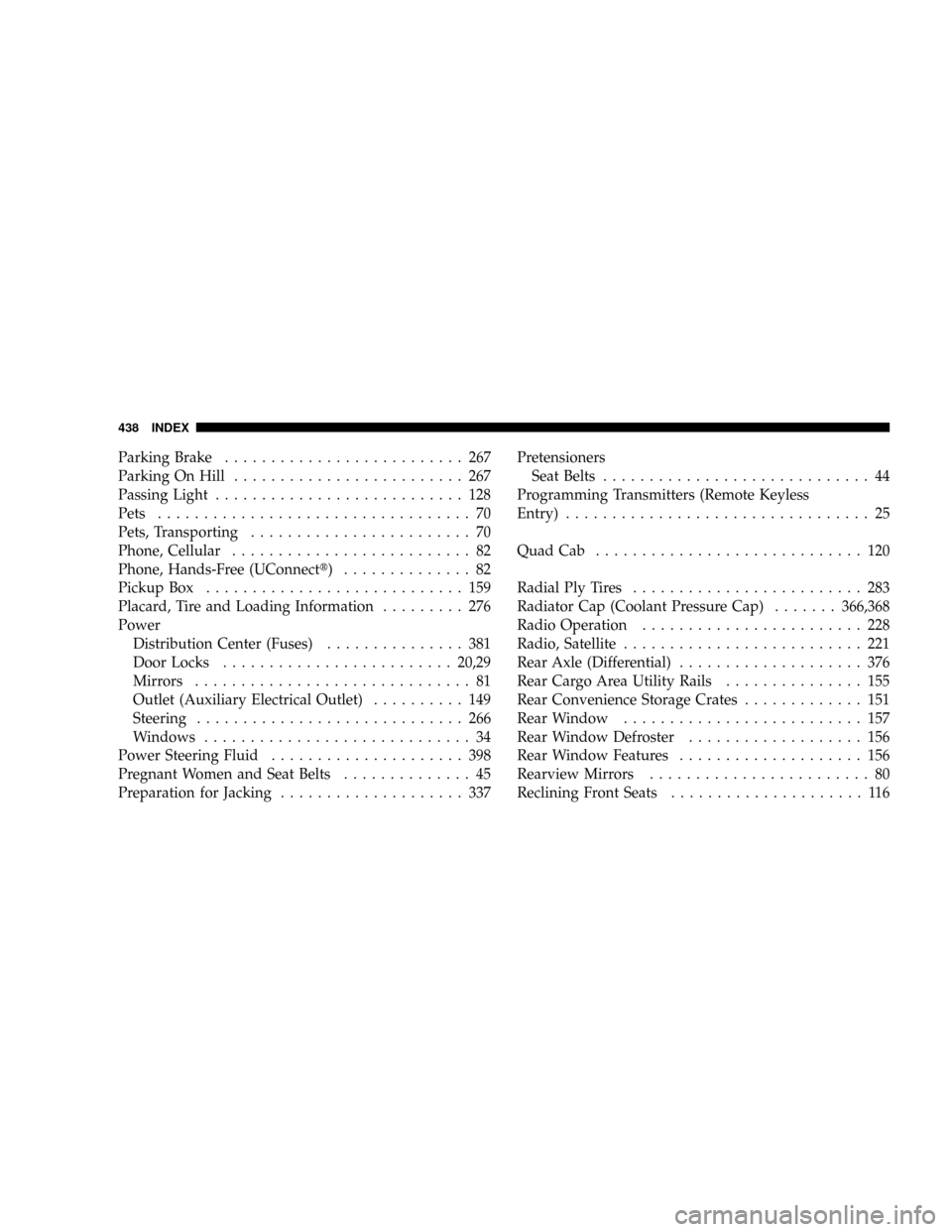
Parking Brake.......................... 267
Parking On Hill......................... 267
Passing Light........................... 128
Pets.................................. 70
Pets, Transporting........................ 70
Phone, Cellular.......................... 82
Phone, Hands-Free (UConnectt) .............. 82
Pickup Box............................ 159
Placard, Tire and Loading Information......... 276
Power
Distribution Center (Fuses)............... 381
Door Locks.........................20,29
Mirrors.............................. 81
Outlet (Auxiliary Electrical Outlet).......... 149
Steering............................. 266
Windows............................. 34
Power Steering Fluid..................... 398
Pregnant Women and Seat Belts.............. 45
Preparation for Jacking.................... 337Pretensioners
Seat Belts............................. 44
Programming Transmitters (Remote Keyless
Entry)................................. 25
Quad Cab............................. 120
Radial Ply Tires......................... 283
Radiator Cap (Coolant Pressure Cap).......366,368
Radio Operation........................ 228
Radio, Satellite.......................... 221
Rear Axle (Differential).................... 376
Rear Cargo Area Utility Rails............... 155
Rear Convenience Storage Crates............. 151
Rear Window.......................... 157
Rear Window Defroster................... 156
Rear Window Features.................... 156
Rearview Mirrors........................ 80
Reclining Front Seats..................... 116
438 INDEX